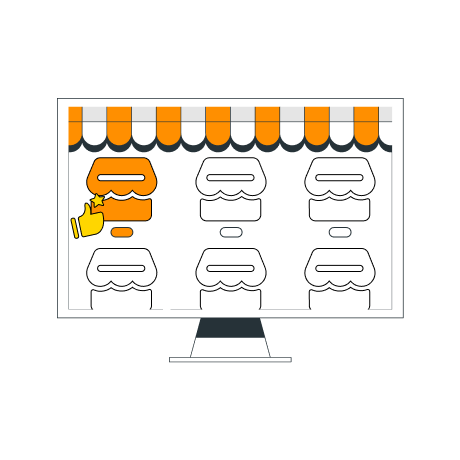The Future of Mobile Commerce: Trends and Predictions

The emergence of mobile commerce (m-commerce) has launched a new era of convenience and accessibility for consumers worldwide. With over 6.8 billion smartphone users across the globe, the potential reach of m-commerce is staggering, allowing businesses to tap into a global market of customers who prefer the ease of shopping on the go.
As of 2022, m-commerce accounted for nearly 66% of global e-commerce sales, and this trend is expected to continue its upward trajectory. So, in this article, we’ll delve into the tendencies that are shaping the future of mobile trade to reveal its disruptive force and help businesses leverage its transformative potential to thrive in a dynamic online landscape.
Mobile Commerce: Where It Stands Now
Mobile Commerce refers to the process of buying, selling, or engaging in financial operations through smartphones and tablets. Unlike traditional e-commerce, which primarily relies on desktop computers or laptops, mobile rade leverages the mobility and connectivity features of these portable gadgets. This enables users to shop online, make payments, and access a wide array of services from virtually anywhere with an internet connection.
M-commerce encompasses various activities, including but not limited to:
- Mobile shopping apps;
- Mobile-optimized websites;
- Mobile wallets;
- Peer-to-peer payment platforms.
The Newstore 2022 research shows that over 60% of customers choose mobile shopping apps over websites and nearly 88% of buyers have some shopping app on their phones.
M-commerce has deeply influenced consumer activity by simulating shoppers to make informed decisions at their own pace, compare prices, read reviews, and access a plethora of options, all from the palm of their hands. Thus, almost 50% of shoppers use mobile devices to compare product and service prices. This shift, in turn, has made businesses adapt and optimize their strategies to meet the demands of an increasingly mobile-centric audience.

|
Find Better Supplier For Products DSers Supplier Optimizer - One click to filter out the most proper suppliers for your products |
While the rise of m-commerce showcases an exciting shift towards mobile, the foundation of this transformation relies heavily on app development. In the current competitive marketplace, businesses are looking to hire mobile app developers who can craft intuitive, user-friendly applications tailored to the ever-evolving demands of consumers.
The right developer not only ensures a seamless shopping experience but also integrates advanced features that set platforms apart in the crowded e-commerce landscape. As mobile becomes the new normal, partnering with skilled developers can determine the success trajectory of a brand.
Booming in 2020 after a noticeable pandemic surge in online shopping, mobile shopping has been showing consistent growth. According to the Insider Intelligence report, total sales from mobile shopping amounted to about $416 billion in 2022 standing for about 6.5% of total annual retail sales. And this rate is expected to hit 8.5% by 2026.
Leading M-Commerce Trends to Observe
With 66% of consumers choosing online shopping over offline, there is a huge potential for further dynamic growth of m-commerce. Currently, there are a few distinctive trends dominating this realm and guiding its future development.
Mobile-First Approach
The number of users accessing the Internet through mobile gadgets increases progressively. So, adopting an approach that prioritizes mobile design is imperative. This involves prioritizing content and features for mobile screens before looking into the desktop experience to ensure that business platforms are optimized for the majority of m-commerce users.
Clear, easily accessible menus, along with familiar gestures like swiping and tapping, allow customers to sail through mobile sites and applications effortlessly. Implementing breadcrumb trails, search functionality, and well-organized categories further streamline the browsing process, helping users find what they need quickly and efficiently.
5G Technology
The advent of 5G stands for a quantum leap in mobile connectivity. With speeds up to 100 times faster than 4G, and significantly reduced latency, 5G promises to transform mobile shopping. This ultra-fast connectivity enables hassle-free streaming, high-quality video calls, and lightning-fast downloads on mobile devices.
In the context of mobile trade, 5G can significantly enhance the performance of mobile apps and sites. Large product images and videos can be uploaded instantly, providing a more involving user experience. Additionally, AR and VR applications can operate with excellent smoothness, allowing for interactive product representation and virtual shopping.
Progressive Web Apps (PWAs)
PWAs combine the best features of both websites and native mobile apps. They offer fast loading times, offline functionality, and the ability to send push notifications. This not only amplifies user engagement but also lets businesses bridge the gap between web and app experiences. With PWAs, customers can enjoy a seamless and app-like experience directly from their mobile browsers, without the need for downloads or installations.
According to Emergen Research, the global PWA market is expected to hit $10.44 billion by 2027 as compared to $1.5 billion in 2020, thus, showing a whopping annual increase of 32% during this period.
Personalization
Personalization is a cornerstone of success in online trade. Leveraging user info and activities, companies can offer tailored product recommendations, making online shopping more relevant and enjoyable. By understanding a customer's preferences, purchase history, and browsing habits, platforms can come up with offers that align with their tastes and needs. Statistically, 80% of customers choose brands that provide personalization.
Allowing users to customize their profiles and preferences fosters a sense of ownership and personalization. This may cover features like saved choices, wish lists, and the ability to set individualized alerts or notifications. Customization options allow users to curate their shopping activities, making them more dedicated and engaged in the platform.
Mobile Wallets
Mobile wallets allow for secure payment information storage, including credit and debit card data, and make operations with a mere tap or scan. Such popular services as Apple Pay, Google Pay, and Samsung Pay have been widely adopted making a seamless and secure alternative to traditional payment methods. In 2022, over 50% of operations were paid with mobile wallets. These digital applications also enable users to manage loyalty cards, boarding passes, and other essential documents in one convenient location.
In the meantime, the rise of contactless payment technology has reshaped how transactions are conducted. By utilizing near-field communication (NFC) tech, users pay by simply waving their mobile devices near a compatible terminal. This method offers a swift, efficient, and hygienic alternative to physical cash or card operations. As such, contactless payments are particularly popular in sectors like retail, transportation, and hospitality, where speed and efficiency are paramount.
When it comes to cryptocurrencies like Bitcoin, understanding how to buy Bitcoin in the UK involves navigating various exchanges and platforms that facilitate digital asset transactions. By registering on established cryptocurrency exchanges like Coinbase or Binance, users in the UK can easily purchase Bitcoin using their preferred payment methods, such as bank transfers or debit/credit cards.
Social Commerce
This segment refers to the integration of social platforms with e-commerce, allowing users to discover, browse, and purchase products directly within the social media environment.
Social selling enables businesses to create shoppable posts and catalogs, showcasing products and services with direct links to seller pages. These visually appealing presentations often benefit from the latest techniques in digital imaging, including AI image sharpening, ensuring that products look their best.
Some social platforms even offer in-app checkout capabilities to complete transactions without being redirected to an external website. This frictionless process promotes sales while reducing the likelihood of cart abandonment.
Predictions to Consider: What’s in the Future of M-Commerce
The future of m-commerce promises a dynamic landscape mainly shaped by technological innovations and advancements. Businesses keeping an eye on these predictions will gain valuable insights to adapt and thrive in this continuously evolving environment.
AR and VR
AR and VR are poised to redefine the way purchasers interact with products and services in the space of mobile sales. AR superimposes digital objects onto the real world, while VR creates an entirely virtual world.
In the context of shopping, AR apps are good for visualizing products in their own physical space before making a purchase. For example, furniture retailers can offer AR tools for clients to place virtual furniture in their living rooms to assess size, style, and fit. VR, on the other hand, can create virtual stores where clients can browse products, interact with staff avatars, and make purchases in a simulated environment.
In 2022, the AR app market is projected to reach $15.5 million revealing promising opportunities for companies to implement simulated reality technology to upgrade their customer experiences.
Artificial Intelligence
AI and machine learning are becoming integral components of mobile trade platforms. AI-driven chatbots, for example, enhance customer support by providing instant responses to inquiries, guiding users through the shopping process, and even suggesting personalized product recommendations based on browsing history and preferences.
AI-powered personalization engines analyze huge blocks of data to deliver tailored shopping experiences. These systems can dynamically adjust product suggestions, pricing, and promotions in real-time, optimizing conversions and customer satisfaction. Additionally, smart algorithms play a crucial role in fraud detection and prevention, safeguarding transactions, and amplifying security in mobile commerce.
Voice Commerce
Voice commerce involves using voice-activated technologies to make purchases, conduct searches, and interact with online platforms. This technology enables users to shop and transact using voice commands, making it a hands-free method of engaging with mobile commerce.
Virtual assistants like Amazon's Alexa, Google Assistant, and Apple's Siri lead the way in this sector. Built into smart gadgets, they provide users with a voice-activated interface to access a wide range of services, including online shopping.
With voice-activated assistants, customers can browse offers, add items to their carts, and make purchases through voice commands. They can specify preferences, ask for recommendations, and even track orders using natural language to enjoy user-friendly shopping.
Voice shopping is undoubtedly the future of e-commerce. Over 71% of consumers already prefer voice search to manual one, not to mention that voice shopping sales have increased by ten times since 2018 and hit $20 billion in 2022.
Blockchain
Blockchain quickly permeates multiple industries to enhance online security and transparency in transactions. M-commerce is not an exception. The technological aspects that open up new possibilities for the future of mobile commerce include:
- Decentralized Ledger: Blockchain operates on a distributed register system, which means that operations records are distributed across a network of computers, making it highly resistant to tampering or fraud. Such a decentralized nature instills trust in m-commerce operations;
- Smart Contracts: These contracts automatically execute and enforce agreements when predetermined conditions are met. In mobile trade, they will streamline and secure transactions by eliminating the need for mediators and ensuring that contractual terms are upheld;
- Cryptocurrencies and Mobile Payments: Blockchain forms the backbone of cryptocurrencies like Bitcoin and Ethereum, which are used for mobile commerce operations. They leverage blockchain's security and transparency features to facilitate peer-to-peer payments and cross-border transactions without the need for traditional financial intermediaries.
Real-Life Examples of Brands Using Advanced M-Commerce Practices
While some companies only consider investing in progressive practices to optimize mobile shopping, others have already embraced technological innovations to provide maximum convenience, personalization, and efficiency for their consumers.
- Alibaba: The Chinese e-commerce giant introduced a PWA that significantly improved mobile load times, allowing users to enjoy a web-browser shopping experience on their mobile devices without having to download a separate app;
- IKEA: A signature Place app enables buyers to visualize how furniture would look in their own homes before making a purchase. By using the smartphone's camera, they can superimpose virtual furniture onto their actual living space;
- Sephora: Sephora’s Virtual Artist utilizes an AI-powered chatbot that makes individual beauty recommendations to customers. It offers virtual try-ons of various makeup products for the users to make more informed buying decisions;
- Starbucks: The Starbucks mobile app incorporates a mobile wallet feature, allowing buyers to make seamless payments and earn rewards through their smartphones. This practice simplifies the checkout process and enhances loyalty program engagement;
- Uber: Uber’s intuitive and user-friendly mobile app is a prime example of putting the mobile experience at the forefront. The design prioritizes simplicity, making it easy for users to request rides with just a few taps;
- Target: Target sends custom-tailored offers and promotions to customers when they are near a store. Such an approach combines location data with user interests to deliver highly relevant and timely messages.
These brands have successfully enhanced their mobile commerce offerings, driving customer satisfaction and loyalty. You can also turn your attention to industries, as many successful companies do. For example, on Coindataflow.com predicts, you can learn about all the risks and disadvantages.
Conclusion
The future of mobile commerce is filled with promise and potential. By understanding and embracing key trends, organizations can hit the forefront of this dynamic and ever-evolving landscape. As buyers increasingly turn to mobile devices for their shopping needs, the opportunities for innovative, customized, and hassle-free mobile commerce experiences are boundless.
Author bio:
Roy Emmerson is the co-founder of TechTimes.com, a B2B SaaS platform that helps businesses stay up-to-date on the latest technology trends. With over a decade of experience in the tech industry, Roy is a thought leader in the field and is passionate about helping companies embrace new technologies to improve their operations and drive growth.











 Company
Company
 Why Choose DSers
Why Choose DSers
 Blog
Blog
 Help Center
Help Center




 Live Chat
Live Chat